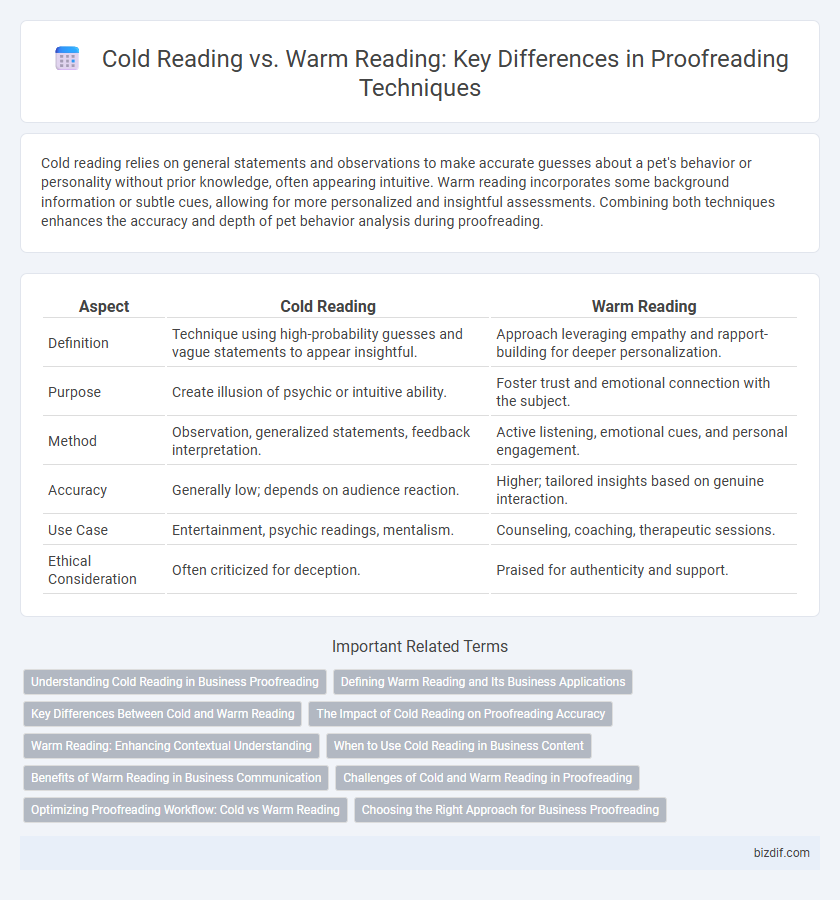Cold reading relies on general statements and observations to make accurate guesses about a pet's behavior or personality without prior knowledge, often appearing intuitive. Warm reading incorporates some background information or subtle cues, allowing for more personalized and insightful assessments. Combining both techniques enhances the accuracy and depth of pet behavior analysis during proofreading.
Table of Comparison
| Aspect | Cold Reading | Warm Reading |
|---|---|---|
| Definition | Technique using high-probability guesses and vague statements to appear insightful. | Approach leveraging empathy and rapport-building for deeper personalization. |
| Purpose | Create illusion of psychic or intuitive ability. | Foster trust and emotional connection with the subject. |
| Method | Observation, generalized statements, feedback interpretation. | Active listening, emotional cues, and personal engagement. |
| Accuracy | Generally low; depends on audience reaction. | Higher; tailored insights based on genuine interaction. |
| Use Case | Entertainment, psychic readings, mentalism. | Counseling, coaching, therapeutic sessions. |
| Ethical Consideration | Often criticized for deception. | Praised for authenticity and support. |
Understanding Cold Reading in Business Proofreading
Cold reading in business proofreading involves analyzing a document without prior knowledge of the author's style or intent, relying on keen observation and inference to identify errors and inconsistencies. This technique emphasizes detecting ambiguous language, tone mismatches, and structural issues by interpreting subtle textual cues. Mastery of cold reading enables proofreaders to provide objective, unbiased feedback that enhances overall communication clarity and professionalism.
Defining Warm Reading and Its Business Applications
Warm reading involves making high-probability guesses about an individual's personality, preferences, and background based on subtle cues and common human experiences. This technique enhances business communications by creating personalized interactions that build trust and rapport without requiring extensive prior knowledge. In marketing, sales, and customer service, warm reading improves engagement and responsiveness by tailoring messages to resonate with target audiences.
Key Differences Between Cold and Warm Reading
Cold reading relies on interpreting subtle cues and making high-probability guesses without prior information, while warm reading involves partial knowledge or contextual clues about the subject. Cold reading techniques often include analyzing body language and vocal tone to infer details, whereas warm reading leverages known background data for more accurate insights. The key difference is that cold reading operates with minimal prior knowledge, contrasting with warm reading's use of existing information to enhance accuracy.
The Impact of Cold Reading on Proofreading Accuracy
Cold reading in proofreading involves assessing text without prior knowledge of the material, which can lead to overlooked errors and reduced accuracy. This method relies heavily on immediate comprehension and intuition, increasing the risk of missing context-dependent mistakes. Warm reading, contrastingly, enhances proofreading accuracy by allowing familiarity with the content, enabling more thorough and precise error detection.
Warm Reading: Enhancing Contextual Understanding
Warm reading enhances contextual understanding by leveraging subtle cues such as tone, body language, and phrasing to build a more accurate interpretation of the text. This method allows proofreaders to capture nuanced meanings and implied information that cold reading might overlook. By integrating emotional and contextual insights, warm reading significantly improves the precision of content correction and stylistic refinement.
When to Use Cold Reading in Business Content
Cold reading proves valuable in business content when initial audience insights are limited or when rapid judgment of consumer sentiment is required. It allows marketers to craft messages that resonate broadly without prior data, leveraging general social cues and assumptions. Employ cold reading to gauge reactions during presentations, improve customer interactions, or tailor pitches in real-time without extensive preparatory research.
Benefits of Warm Reading in Business Communication
Warm reading enhances business communication by creating a personalized and empathetic connection, increasing trust and rapport with clients and colleagues. This approach enables tailored responses that resonate more effectively, improving engagement and reducing misunderstandings. Employing warm reading techniques leads to more meaningful interactions and fosters long-term professional relationships.
Challenges of Cold and Warm Reading in Proofreading
Cold reading in proofreading presents challenges such as the difficulty of identifying errors without prior context, increasing the risk of overlooking subtle mistakes and misinterpreting ambiguous phrases. Warm reading benefits from familiarity with the material, yet it may introduce bias that causes proofreaders to skip over repeated errors or assume correctness. Balancing objectivity and insight remains essential to effectively detect inconsistencies, typographical errors, and contextual inaccuracies in both cold and warm reading scenarios.
Optimizing Proofreading Workflow: Cold vs Warm Reading
Cold reading in proofreading involves evaluating a text with fresh eyes, enhancing error detection by minimizing familiarity bias and promoting objective assessment. Warm reading, however, focuses on understanding context and meaning by reviewing the text with some prior exposure, aiding in identifying stylistic inconsistencies and improving flow. Optimizing proofreading workflow combines cold reading's accuracy in spotting mechanical errors with warm reading's strength in refining coherence and tone, resulting in a comprehensive and efficient editing process.
Choosing the Right Approach for Business Proofreading
Cold reading in business proofreading involves analyzing text with minimal prior knowledge, ensuring objectivity and fresh perspective for error detection. Warm reading, by contrast, leverages familiarity with the document's purpose and context, enabling nuanced edits that align with brand voice and target audience expectations. Selecting the right approach depends on project goals: choose cold reading for factual accuracy and unbiased error spotting, and warm reading for refining tone, style, and strategic messaging.
cold reading vs warm reading Infographic

 bizdif.com
bizdif.com